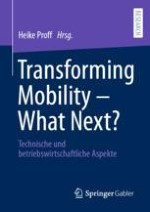2022 | OriginalPaper | Buchkapitel
2. Transformation etablierter Unternehmen im Übergang in die Elektromobilität
verfasst von : Heike Proff, Fabian Falk, Daniel Jaspers
Erschienen in: Transforming Mobility – What Next?
Verlag: Springer Fachmedien Wiesbaden
Aktivieren Sie unsere intelligente Suche, um passende Fachinhalte oder Patente zu finden.
Wählen Sie Textabschnitte aus um mit Künstlicher Intelligenz passenden Patente zu finden. powered by
Markieren Sie Textabschnitte, um KI-gestützt weitere passende Inhalte zu finden. powered by
